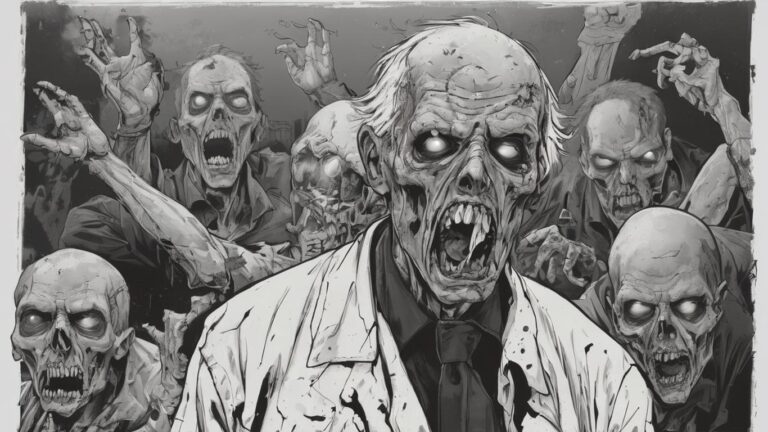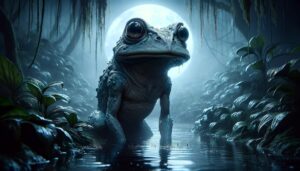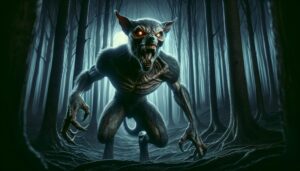Table of Contents
Physical Description
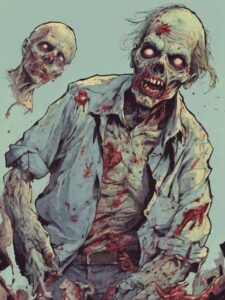
The physical description of zombies in mythology and popular culture can vary, but there are some common characteristics associated with these reanimated corpses. Keep in mind that different stories and depictions may deviate from these general traits:
Corpse-Like Appearance: Zombies are typically described as having a deathly pale or grayish complexion. Their skin may be discolored, showing signs of decay and decomposition. In some depictions, wounds or injuries from their pre-zombified state are visible.
Lack of Coordination: Zombies are often portrayed as having slow and clumsy movements. Their motor skills are impaired, and they may stumble or shuffle as they move. This lack of coordination adds to the eerie and unsettling nature of their presence.
Empty or Glazed Eyes: The eyes of zombies are often depicted as vacant, soulless, or glazed over. This contributes to the idea that the reanimated corpse is devoid of the consciousness or humanity it once had.
Injuries and Decay: Depending on the depiction, zombies may show signs of physical trauma or decay. This can include missing limbs, exposed bones, and other gruesome injuries. The state of decay may progress over time, reflecting the length of time since the person became a zombie.
Foul Odor: Due to their decaying nature, zombies are often associated with a putrid and unpleasant smell. This detail is sometimes included in stories to highlight the repulsiveness of the undead.
Tattered Clothing: Zombies are commonly portrayed wearing clothing that is torn, dirty, and in a state of disarray. This is consistent with the idea that they have undergone physical trauma and decay.
Unnatural Movements: In addition to their slow and clumsy movements, zombies may exhibit other unnatural behaviors. This can include twitching, convulsions, or the ability to continue moving despite severe injuries.
Hunger for Flesh: A common characteristic of zombies is their insatiable hunger for human flesh. This aspect often plays a central role in the horror and danger associated with encounters with the undead.
Personality

In the traditional portrayal of zombies, their personalities are typically reduced to a primal and instinctual state. Here are some common personality traits associated with zombies in mythology and popular culture:
Mindlessness: Zombies are often depicted as mindless and devoid of conscious thought. Their actions are primarily driven by instinct, and they lack the ability to reason, plan, or make decisions.
Aggression: A defining characteristic of zombies is their aggressive behavior, particularly their relentless pursuit of living humans. The aggression is usually driven by an insatiable hunger for human flesh.
Single-Mindedness: Zombies are singularly focused on their desire to feed on the living. This single-mindedness contributes to their relentless pursuit and the challenges survivors face when trying to evade or combat them.
No Emotional Response: Zombies typically show no emotional responses such as joy, sadness, fear, or love. Their emotional capacities are believed to be extinguished, reinforcing their portrayal as soulless and devoid of humanity.
Absence of Speech: Zombies are generally depicted as mute, with no ability to communicate through speech. This lack of verbal communication adds to their eerie and otherworldly nature.
Group Mentality: In many zombie stories, the undead tend to congregate in groups, forming hordes that move together. While each individual zombie may lack independent thought, their collective presence poses a greater threat to survivors.
Persistence: Zombies are often portrayed as persistent and relentless in their pursuit of prey. They don’t tire or give up easily, making them a formidable and enduring threat.
No Self-Preservation Instinct: Unlike living beings, zombies do not have a self-preservation instinct. They may continue to move and attack even if severely injured or missing body parts.
Origin
The concept of zombies has roots in various cultures and traditions, with influences from folklore, mythology, and religious beliefs. Here are a few key aspects of the origin of zombies:
Haitian Vodou: The term “zombi” is believed to have originated in Haitian Vodou, a syncretic religion that combines elements of African religions with Roman Catholicism. In Vodou, a “zombi” refers to a person who has been reanimated and brought back to life through supernatural means. Contrary to popular Hollywood depictions, traditional Vodou zombies are not typically associated with cannibalism or a craving for human flesh. Instead, they are often thought to be individuals brought back from the dead to serve as slaves.
African and Afro-Caribbean Folklore: Similar concepts of the dead returning to life exist in various African and Afro-Caribbean cultures. These beliefs may involve spirits or entities that can reanimate corpses for specific purposes, often under the control of a practitioner of magic or a religious figure.
Colonial-era Accounts: The idea of the zombie became more widely known in Western cultures through colonial-era accounts of Haitian folklore. Travelers and writers in the 19th and early 20th centuries, such as William Seabrook, wrote about the supposed existence of zombies in Haiti, contributing to the popularization of the concept.
Literary and Cinematic Influence: The modern zombie archetype, as it is commonly known today, was heavily influenced by literature and film. One of the earliest works contributing to the popularization of the zombie myth was William Seabrook’s book “The Magic Island” (1929). However, it was George A. Romero’s film “Night of the Living Dead” (1968) that had a profound impact on shaping the modern zombie narrative. Romero’s zombies were reanimated corpses driven by an insatiable appetite for human flesh, and this portrayal has since become a standard in zombie lore.
Cultural Evolution: Over time, the concept of zombies has evolved and diversified in various cultures worldwide. Different regions have incorporated their own beliefs and mythologies into the zombie narrative, resulting in a wide range of interpretations and characteristics associated with the undead.
The origin of zombies is complex and multifaceted, drawing from a blend of cultural, religious, and literary influences. While the concept of the reanimated dead has ancient roots, the modern popularization and standardization of the zombie archetype owe much to the blending of Vodou traditions with Western literature and cinema.
Modern Appearances
In modern popular culture, zombies have become a prevalent and iconic element in various forms of media, including literature, film, television, video games, and more. The portrayal of zombies has evolved, and different creators have introduced their own twists on the traditional myth. Here are some common modern appearances of zombies:
Film and Television: The zombie genre has been a significant presence in both film and television. George A. Romero’s “Night of the Living Dead” (1968) is often considered a seminal work that established many conventions of the modern zombie. Numerous films and TV series have followed, including “Dawn of the Dead,” “The Walking Dead,” “World War Z,” and “Zombieland,” each contributing to the diverse portrayals of zombies.
Video Games: Zombies are a popular theme in video games, with franchises like “Resident Evil,” “Left 4 Dead,” and “Call of Duty: Zombies” featuring various iterations of undead enemies. These games often incorporate elements of survival horror and action, challenging players to navigate post-apocalyptic environments filled with zombies.
Literature: The zombie genre has expanded in literature with novels and series exploring different aspects of the undead apocalypse. Max Brooks’ “World War Z” and Robert Kirkman’s “The Walking Dead” comic series (adapted into a TV series) are notable examples that have contributed to the popularity of zombie literature.
Comics and Graphic Novels: Zombies have made their mark in the world of comics and graphic novels. In addition to “The Walking Dead,” other works, such as “Marvel Zombies” and “Plants vs. Zombies,” showcase a range of creative and often humorous takes on the zombie theme.
Pop Culture References: Zombies have become ubiquitous in pop culture, making appearances in music, art, and even advertising. The imagery of zombies has been adapted for comedic purposes, as seen in works like “Shaun of the Dead” and the “Zombieland” film series.
Diverse Interpretations: While traditional zombies are often depicted as slow-moving, mindless creatures, modern interpretations have introduced variations. Some stories feature fast-moving zombies, intelligent zombies, or zombies with unique abilities. Additionally, the cause of zombification may vary, ranging from viruses to supernatural forces.
Exploration of Themes: Modern zombie narratives often go beyond mere horror and explore themes such as survival, morality, societal collapse, and human nature under extreme conditions. The genre has become a vehicle for social commentary and allegory.
Zombies continue to be a dynamic and enduring element in contemporary storytelling, adapting to new mediums and evolving cultural contexts while maintaining their status as iconic figures in the horror genre.
Similar creatures
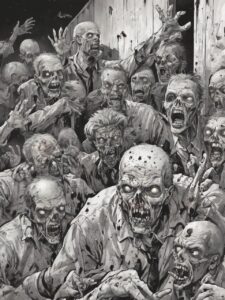
Several creatures from various mythologies and folklore share similarities with zombies in terms of being reanimated or undead beings with a connection to death and the afterlife. We described some related creatures:
Ghouls: In Arabian folklore, ghouls are creatures that dwell in graveyards and are often associated with consuming the flesh of the dead. They share similarities with zombies in their association with death and the supernatural.
Draugr: In Norse mythology, a draugr is an undead creature, often the reanimated corpse of a deceased person. These beings retain some semblance of intelligence and possess superhuman strength.
Jiangshi: A creature from Chinese folklore, the jiangshi is a reanimated corpse that absorbs the life force of the living. It is often depicted as a hopping vampire, displaying similarities with the undead.
Revenant: In European folklore, a revenant is a deceased person who has returned from the grave. Like zombies, revenants may seek revenge or have unfinished business with the living.
Wights: In Old English and Norse mythology, wights are spirits or supernatural beings associated with the dead. They can be malevolent entities connected to burial sites and graveyards.
Ankou: In Breton folklore, Ankou is a personification of death often depicted as a skeletal figure or a grave-digger. While not a reanimated corpse, Ankou is associated with the dead and the afterlife.
Nachzehrer: In German folklore, the nachzehrer is a type of revenant or vampire that is said to devour its own shroud and may cause the death of relatives by consuming their life force.
Vetala: In Hindu mythology, the vetala is a revenant spirit or ghost that can animate dead bodies. These creatures are often associated with possession and may bring both harm and wisdom.
